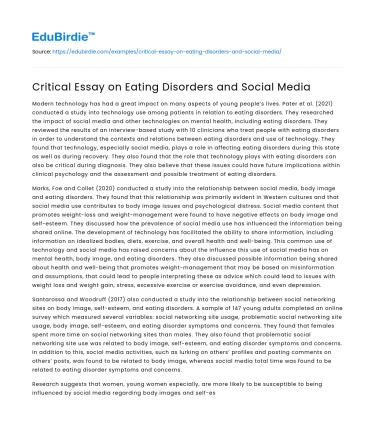Modern technology has had a great impact on many aspects of young people’s lives. Pater et al. (2021) conducted a study into technology use among patients in relation to eating disorders. They researched the impact of social media and other technologies on mental health, including eating disorders. They reviewed the results of an interview-based study with 10 clinicians who treat people with eating disorders in order to understand the contexts and relations between eating disorders and use of technology. They found that technology, especially social media, plays a role in affecting eating disorders during this state as well as during recovery. They also found that the role that technology plays with eating disorders can also be critical during diagnosis. They also believe that these issues could have future implications within clinical psychology and the assessment and possible treatment of eating disorders.
Marks, Foe and Collet (2020) conducted a study into the relationship between social media, body image and eating disorders. They found that this relationship was primarily evident in Western cultures and that social media use contributes to body image issues and psychological distress. Social media content that promotes weight-loss and weight-management were found to have negative effects on body image and self-esteem. They discussed how the prevalence of social media use has influenced the information being shared online. The development of technology has facilitated the ability to share information, including information on idealized bodies, diets, exercise, and overall health and well-being. This common use of technology and social media has raised concerns about the influence this use of social media has on mental health, body image, and eating disorders. They also discussed possible information being shared about health and well-being that promotes weight-management that may be based on misinformation and assumptions, that could lead to people interpreting these as advice which could lead to issues with weight loss and weight gain, stress, excessive exercise or exercise avoidance, and even depression.
Save your time!
We can take care of your essay
- Proper editing and formatting
- Free revision, title page, and bibliography
- Flexible prices and money-back guarantee
Santarossa and Woodruff (2017) also conducted a study into the relationship between social networking sites on body image, self-esteem, and eating disorders. A sample of 147 young adults completed an online survey which measured several variables: social networking site usage, problematic social networking site usage, body image, self-esteem, and eating disorder symptoms and concerns. They found that females spent more time on social networking sites than males. They also found that problematic social networking site use was related to body image, self-esteem, and eating disorder symptoms and concerns. In addition to this, social media activities, such as lurking on others’ profiles and posting comments on others’ posts, was found to be related to body image, whereas social media total time was found to be related to eating disorder symptoms and concerns.
Research suggests that women, young women especially, are more likely to be susceptible to being influenced by social media regarding body images and self-esteem. Irving (2011) studied the effects of ideal beauty standards on self-esteem and body image among women who show varying levels of bulimic symptoms. The typical onset of bulimia is during adolescence and early adulthood and is characterized by a fear of weight gain and distorted body image. There is often a greater dissatisfaction with body proportions and distortion of true body size among individuals with bulimia. As discussed in the study, research suggests that the increase in preference among women for thinner body shapes could be associated with increases in the prevalence of eating disorders and eating-related issues. In Irving’s study, they looked at the impact of exposure to images on thin, average, and oversized models on women’s self-evaluations who show varied levels of bulimic symptoms. They found that young women adopt an ideal body shape goal that is only achievable for 5% of the population. The results showed that regardless of level of bulimic symptoms, exposure to thin models was found to be related or lower self-evaluations. In addition to this, women who reported high levels of bulimic symptoms also reported greater pressure to be thin due to media, peers, and family.
In conclusion, there is a great amount of research that supports the impact of technology on eating disorders. Research suggests that the main reasons how technology, and in particular social media, contributes to eating disorders among young people are through the promotion of weight-management, which can be construed negatively and lead to many issues for young people, including self-esteem, body image issues, eating disorders, and depression. Due to social media, young people often view unrealistic body shapes and will risk their health and well-being trying to achieve these ‘ideal’ body types.






 Stuck on your essay?
Stuck on your essay?

